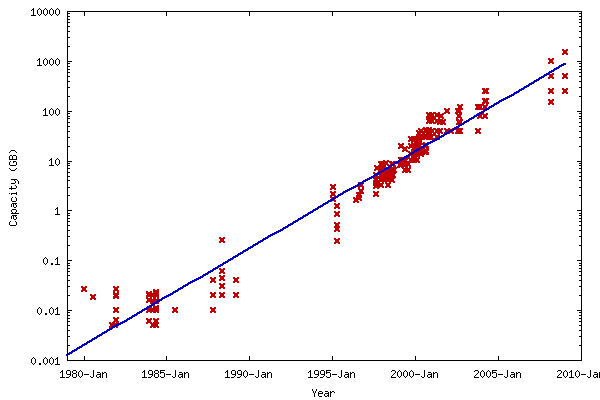 |
This is a file from the Wikimedia Commons. Information from its description page there is shown below.
Commons is a freely licensed media file repository. You can help.
|
 |
This graph image was uploaded in a raster graphics format such as PNG, GIF, or JPEG. However, it contains information that could be stored more efficiently and/or accurately in the SVG format, as a vector graphic.
If possible, please upload an SVG version of this image. After confirming it is of comparable quality, please replace all instances of the previous version throughout Wikipedia (noted under the "File links" header), tag the old version with {{ Vector version available|NewImage.svg}} |
 |
Based on en:Image:KrydersLaw.png:
 |
The factual accuracy of this diagram is disputed The dispute is about: WARNING: This graph is highly misleading since it is based upon advertised retail products and at least in the 1980s misses the higher capacity drives which generally were not offered at retail. For example, the highest capacity disk drive listed and plotted for 1981 is 26MB while the actual highest capacity HDD then offered was the IBM 3380 at 2,520 MB per disk drive (2 HDAs per disk drive box). By the late 90s high performance drives were readily available at retail. Tom94022 ( talk) 06:10, 25 March 2009 (UTC) Please discuss the issue on this diagram's talk page. For usage see: {{ disputed diagram|why|…}}
|
Current version including 2008 data. Script and data to generate the plot below. I donate this version (including the 2008 data) to the public domain. Hankwang 17:00, 2 March 2008 (UTC)
 |
File:Hard drive capacity over time.svg is a vector version of this file.
It should be used in place of this raster image when superior.
File:Hard drive capacity over time.png  File:Hard drive capacity over time.svg
For more information about vector graphics, read about Commons transition to SVG.
There is also information about MediaWiki's support of SVG images.
|
|
| Public domainPublic domainfalsefalse |
 |
I, the copyright holder of this work, release this work into the public domain. This applies worldwide.
In some countries this may not be legally possible; if so:
I grant anyone the right to use this work for any purpose, without any conditions, unless such conditions are required by law.Public domainPublic domainfalsefalse
|
See also: File talk:Hard drive capacity over time.png#Data
Old description
" Personal Computer hard disk drive capacity (in gigabytes) over time. Data culled from . This is very much a first cut -- an improved image with more data extending further back in time would be much better than this. The spreadsheet I used is available; leave me a message on my talk page."
Created by User:Omegatron using the GIMP
I, the copyright holder of this work, hereby publish it under the following licenses:
 |
Permission is granted to copy, distribute and/or modify this document under the terms of the GNU Free Documentation License, Version 1.2 or any later version published by the Free Software Foundation; with no Invariant Sections, no Front-Cover Texts, and no Back-Cover Texts. A copy of the license is included in the section entitled GNU Free Documentation License. http://www.gnu.org/copyleft/fdl.htmlGFDLGNU Free Documentation Licensetruetrue
|
You may select the license of your choice.
|
(In short, this means that you can copy and modify the image freely as long as you provide attribution; preferably in the form of a link back to this page.)
File usage
The following pages on Schools Wikipedia link to this image (list may be incomplete):
SOS Childrens Villages has brought Wikipedia to the classroom. SOS Children works in 133 countries and territories across the globe, helps more than 62,000 children, and reaches over 2 million people in total. Sponsoring a child is the coolest way to help.








